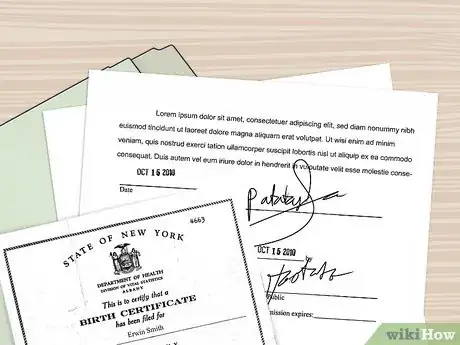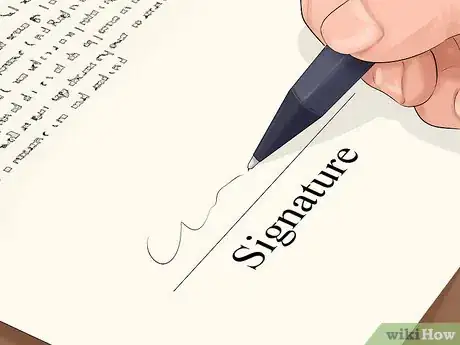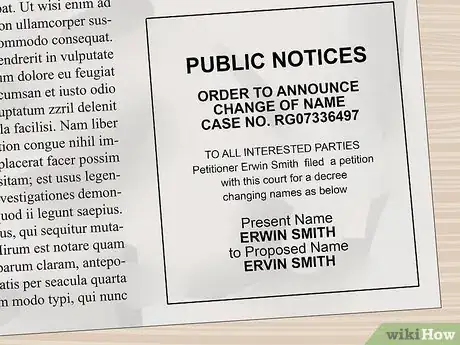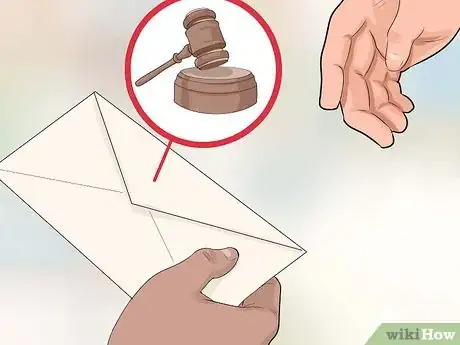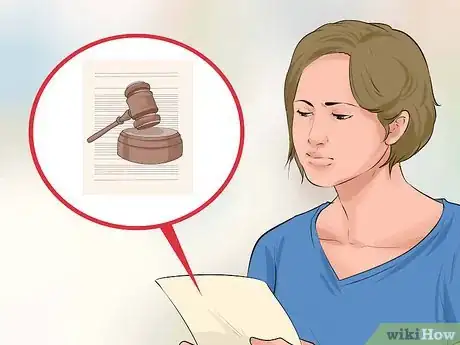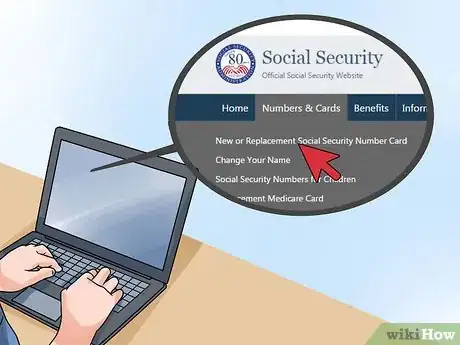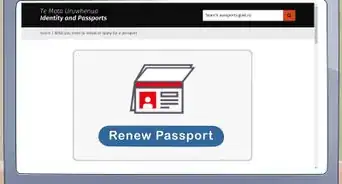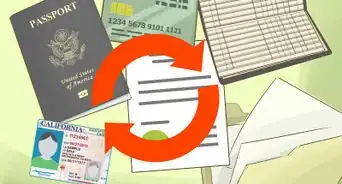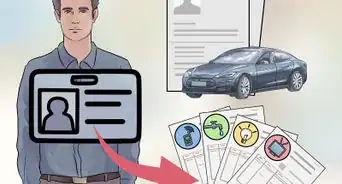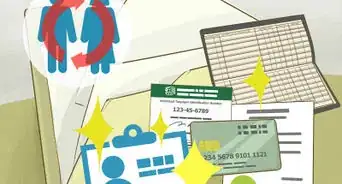This article was co-authored by Clinton M. Sandvick, JD, PhD. Clinton M. Sandvick worked as a civil litigator in California for over 7 years. He received his JD from the University of Wisconsin-Madison in 1998 and his PhD in American History from the University of Oregon in 2013.
There are 12 references cited in this article, which can be found at the bottom of the page.
This article has been viewed 48,730 times.
You may want to change your child’s name because of remarriage, divorce, or another reason. Alternately, your minor child might want to change their name. The process of changing a child's legal name will differ depending on the state. Generally, you will need to file a petition with the court where the child lives and pay a filing fee. If the court agrees that the name change is in the child’s best interest, then you can change the child’s birth certificate.
Steps
Completing Preliminary Steps
-
1Understand the reasons a name change will be granted. The proposed name change must be approved by a judge, and approval will not be given in every circumstance. Often, a name change will be granted in the following situations:[1]
- Both parents petition the court for the name change
- One parent petitions the court and the other parent, after notification, does not object
- One parent petitions the court and the other parent either cannot be found or has abandoned the child
-
2Analyze whether the name change is in the child’s “best interest.” If the other parent objects to the name change, then the court will have to hold a hearing. At the hearing, the judge will have to decide whether a name change is in the child’s best interest. There is no one definition of “best interest,” but the court will consider a variety of factors:[2]
- the length of time that the child has used the current name
- the effect a name change will have on preserving the child’s relationship with both parents
- the child’s relationship with each parent
- the child’s need to identify with a new family unit through the use of a common name
- the wishes of the child (if older)
- any other relevant factor
Advertisement -
3Talk to the child. In some states, a child must agree to a name change once they reach a certain age. In Texas, a child over 10 must agree to the name change.
- Even if the child is young, you should still ask the child how they feel about a name change. Courts will consider this a relevant factor in deciding whether to grant a name change.[3]
-
4Consult with the child's other parent. Most states and judges require that both parents agree before they will change a child's name. If the other parent will not agree, you may still ask the court for a change and explain your reasons at a hearing. By talking with the other parent, you can feel out whether or not they will object to the name change.
- If the other parent agrees, then you will want to discuss plans for filling out the paperwork and potentially attending the hearing together.
-
5Find the correct court. You will need to petition a court to change the child’s name. The court you use will depend on your state’s rules. In many states, you go to the court in the county where the child lives.
- Some states, such as Michigan, require the child to have lived in the county for at least one year.[4]
- If you don’t know where to go, call your court clerk and ask which court you would use.
-
6Gather necessary documents. You may need to present to the court the child’s birth certificate and/or a death certificate for a parent.[5]
- To get a birth certificate, you can visit your state’s Vital Statistics office. You should be able to order birth certificates through the VitalChek website.
- To get a death certificate, see wikiHow’s How to Acquire a Death Certificate for more information.
-
7Collect the necessary forms. Each state should have pre-printed, “fill in the blank” forms for you to use. Often, a state will have different forms depending on whether the other parent agrees or objects to the name change.[6] The forms may go by different names depending on the state. You can ask the court clerk or look on the court’s website.
- In West Virginia, you must fill out a Petition, which can be found here. You must also file a Civil Case Information Statement, which is available here.
- In Texas you would fill out an “Original Joint Petition for Child’s Name Change” if both parents agree. You would also need a “Child’s Consent To Name Change” form (if the child is over 10) and an “Agreed Order Granting Child’s Name Change.” If both parents don’t agree, then you would file an “Original Petition for Change of Name.”[7] A sample form for Collin County is available here.
- In Michigan, you would need a “Petition to Change Name,” which is available here.
Petitioning the Court
-
1Fill out the forms. Fill out the forms using a typewriter or a pen with blue or black ink. Each state’s form may ask for slightly different information, but you will probably be asked for:[8]
- the child’s current name and age
- each parent’s name and address
- confirmation that the child is a resident of the county where you will file the petition
- the reason for the name change
- the new name requested
- confirmation that a name change isn’t sought to avoid debt/creditors or any law regarding identity
- agreement that the petitioner is not a registered sex offender
- agreement that the name change is not sought for an illegal or improper purpose, such as evading detection or arrest
- confirmation that the petitioner is not a convicted felon
-
2Have the petition verified. You may need to sign your petition in front of a notary.[9] Notaries may be found at most large banks and at courthouses.
- You may also be able to find a notary by visiting your state’s Secretary of State website, which might run a directory of notaries.
- Be sure to bring acceptable methods of personal identification. Typically, a valid driver’s license or passport will suffice.
-
3File the forms. After you have filled out the forms and had them notarized, you need to take them all to the court clerk to file.[10] Be sure to make at least three copies: one for the other parent and two copies for your records.
- When you file the original forms, the court clerk will stamp them with the date. Make sure to have all of your copies stamped as well.
-
4Pay the fee. You may have to pay a filing fee. The fee varies widely by state and by court. In New York, you will pay $65.[11] In Thurston County, Washington, you will pay a total fee of $151.00.[12] Call ahead of time to ask the clerk for the amount and acceptable methods of payment.
- If you cannot afford the fee, then ask for a fee waiver form.[13]
- Fee waiver forms often ask for financial information, such as your current yearly take-home pay from all sources (job, benefits, public assistance, alimony, etc.) You probably will also be asked for monthly expenses, such as mortgage, rent, car payment, loan payments, food, utilities, and medical care.[14] If you don’t think you can afford the fee, then gather this financial information so that you can fill out the waiver form accurately.
-
5Serve notice to the other parent. You need to notify the other parent that you have petitioned the court to change the child’s name. You must give this notice even if you have sole custody.[15] Talk to the clerk about acceptable methods of serving notice.
- Typically, notice can be sent in a variety of ways. For example, the other parent could sign an Acceptance of Service form in front of a notary. You would then file it with the court.[16]
- The other parent can often be notified through personal service, either using the sheriff or a private process server.[17] You will probably have to pay a fee. Process servers cost around $45-70.[18] It usually costs a little less to use the sheriff.[19]
- Many courts will also allow anyone over 18 who is not a party to the court action to serve the papers. Whoever provides personal service will typically have to file with the court an affidavit attesting that service was made.[20] [21]
-
6Publish notice. You may have to file Legal Notice in a print publication, such as a legal newspaper. In West Virginia, you must publish a notice in a newspaper in the county where you filed the petition at least 10 days before the hearing.[22]
- Ask the clerk for a list of acceptable newspapers. You may be limited to specific ones.
- You may have to pay a fee in order to publish the name change. Fees can vary. For example, in Genesee County, Michigan, you will have to pay $80.25 to publish in the Flint-Genesee County Legal News.[23] In Orange County, California, you can publish in The Notice for a $60 flat fee.
- If you can’t afford the fee, then you should be able to motion the court for a fee waiver.[24] Ask the clerk for the form.
-
7File proof of publication. After the name change has appeared in the newspaper, you will need to file proof with the court.[25] Ask the clerk for what form you need to fill out.
-
8Attend a hearing. At the hearing, the judge will review the information in the petition. The judge may also go through the prohibited reasons for getting a name change and ask you to testify under oath that you are not seeking the name change for a prohibited reason.[26]
- If the other parent objects, then the court will need to hear the reasons for the objection. Ultimately, the court must decide whether the name change is in your child’s best interest.
- You may be tasked with writing the order, which the judge will sign. You can ask the court clerk when you pick up your forms whether or not you must fill out an order. Typically, there will be a form for you to fill out.[27]
-
9Get a certified order. If the name change is granted, then the judge will sign an order to that effect. You will then need a certified order, Name Change Certificate, or some other official document to present to Social Security and to have your child’s name changed on a birth certificate. If the name change is granted, ask the clerk what form you will need.
Notifying Others of the Name Change
-
1Notify the Bureau of Vital Statistics. Once a name change is ordered, the name on the child’s birth certificate does not automatically change. You will need to contact your state’s Vital Statistics department and present them with the necessary form.
- After the change is made on the birth certificate, you should get certified copies of the birth certificate. You may need them in the future and should have a couple copies handy.
-
2Contact Social Security. You need to alert the Social Security Administration of a child’s name change and complete an application for a corrected Social Security card (if the child already has one). The number will stay the same though the name will be changed.ocial Security Administration website[28]
- You can download this application and fill it out. You can then submit it to any Social Security office.
- Find the office nearest you by using this Locator.
-
3Tell your child’s school of the name change. Make sure that the school knows of the child’s name change. Also notify any medical professional who your child has received services from, such as doctors, dentists, and therapists.
Warnings
- Changing a name does not alter the parent’s legal rights and responsibilities to a child. For example, if you agree to a name change your parental rights are not terminated and you are not relieved of child support obligations.⧼thumbs_response⧽
References
- ↑ http://www.divorcenet.com/resources/divorce/changing-a-childs-name.htm
- ↑ http://www.divorcenet.com/resources/divorce/changing-a-childs-name.htm
- ↑ http://www.divorcenet.com/resources/divorce/changing-a-childs-name.htm
- ↑ http://info.legalzoom.com/minor-child-name-change-laws-michigan-25853.html
- ↑ http://www.gc4me.com/departments/county_clerks1/docs/Legal/MinorNameChange.pdf?_ga=1.209710677.630696934.1428484745
- ↑ http://info.legalzoom.com/change-childs-last-name-sole-custody-20249.html
- ↑ http://www.collincountytx.gov/law_library/Documents/online_forms/NameChangeMinorOneParent.pdf
- ↑ http://www.lawv.net/Resources/Self-Help-Library/Individual-Rights/Changing-Your-Childs-Name
- ↑ http://www.lawv.net/Resources/Self-Help-Library/Individual-Rights/Changing-Your-Childs-Name
- ↑ http://info.legalzoom.com/change-childs-last-name-sole-custody-20249.html
- ↑ https://www.nycourts.gov/courts/nyc/civil/int_minornamechange.shtml
- ↑ http://www.co.thurston.wa.us/distcrt/docs/Minor-Name-Change-Info-Sheet.pdf
- ↑ http://www.lawv.net/Resources/Self-Help-Library/Individual-Rights/Changing-Your-Childs-Name
- ↑ http://www.courtswv.gov/legal-community/court-rules/civil-procedure/pdf/Affidavit.pdf
- ↑ http://www.divorcenet.com/resources/divorce/changing-a-childs-name.htm
- ↑ http://www.lawv.net/Resources/Self-Help-Library/Individual-Rights/Changing-Your-Childs-Name
- ↑ http://www.lawv.net/Resources/Self-Help-Library/Individual-Rights/Changing-Your-Childs-Name
- ↑ http://www.serve-now.com/about-process-serving
- ↑ http://www.serve-now.com/articles/841/process-server-vs-sheriff-infographic
- ↑ http://www.lawv.net/Resources/Self-Help-Library/Individual-Rights/Changing-Your-Childs-Name
- ↑ http://www.gc4me.com/departments/county_clerks1/docs/Legal/MinorNameChange.pdf?_ga=1.209710677.630696934.1428484745
- ↑ http://www.lawv.net/Resources/Self-Help-Library/Individual-Rights/Changing-Your-Childs-Name
- ↑ http://www.gc4me.com/departments/county_clerks1/docs/Legal/MinorNameChange.pdf?_ga=1.209710677.630696934.1428484745
- ↑ http://www.lawv.net/Resources/Self-Help-Library/Individual-Rights/Changing-Your-Childs-Name
- ↑ http://www.lawv.net/Resources/Self-Help-Library/Individual-Rights/Changing-Your-Childs-Name
- ↑ http://www.lawv.net/Resources/Self-Help-Library/Individual-Rights/Changing-Your-Childs-Name
- ↑ http://www.gc4me.com/departments/county_clerks1/docs/Legal/MinorNameChange.pdf?_ga=1.209710677.630696934.1428484745
- ↑ https://spie.org/Documents/Courses/SocialSecurityApplicationSS-5.pdf
- ↑ http://www.lawv.net/Resources/Self-Help-Library/Individual-Rights/Changing-Your-Childs-Name





